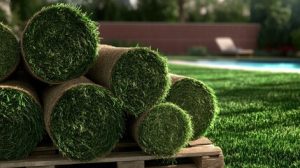Artificial turf has become a familiar sight in many outdoor and indoor spaces. Its rapid adoption sparks debates about its true value. While it promises a polished aesthetic, it also raises complex concerns. The reality of its impact stretches far beyond appearance.

One advantage is its consistency in visual appeal throughout the year. It remains green and trimmed without seasonal changes. This predictability reduces the need for constant landscaping. Users gain control over the look of their surroundings. Keep reading the article below to learn more about Pros and Cons of Artificial Turf.
Maintenance demands are notably lower compared to natural grass. There is no need for watering, mowing, or fertilizing. This reduces recurring labor and supply expenses. It frees time for other responsibilities or creative projects.
Artificial turf also withstands heavy use without quick deterioration. It resists foot traffic that would otherwise create bare patches. This durability makes it appealing for high-activity zones. It keeps spaces functional regardless of wear.
Another strength lies in its ability to conserve water. Eliminating irrigation aligns with sustainable resource practices. This is especially beneficial in regions prone to water stress. It turns landscaping from a drain into a conservation measure.
However, artificial turf brings unique challenges that often go unnoticed. One issue is the buildup of heat on its surface. It can become uncomfortable or unsafe during prolonged sun exposure. This limits its usability during peak daylight hours.
There is also the question of its long-term environmental footprint. Synthetic materials often involve energy-intensive manufacturing. When discarded, they contribute to persistent waste. This complicates its image as an eco-friendly option.
Artificial turf can disrupt the natural soil ecosystem underneath it. The barrier prevents organic matter from reaching the ground. This gradually reduces soil health and microbial diversity. The surface below may become compacted and lifeless.
Another drawback is the absence of natural cooling properties. Real grass cools its surroundings through transpiration. Artificial turf does not provide this benefit. It can intensify the heat island effect in dense areas.
The initial installation cost can also be a significant hurdle. Preparing the ground and securing the turf demands precise work. This upfront expense can be higher than planting real grass. Long-term savings only appear over time.
Artificial turf offers no support to local biodiversity. Insects, birds, and small creatures find nothing to feed on or inhabit. It creates sterile zones within outdoor spaces. This reduces ecological variety and resilience.
There are also concerns about microplastic shedding as turf ages. The fibers gradually break down into tiny particles. These can be carried by wind or water into nearby environments. Their long-term ecological effects are still unfolding.
Despite its durability, artificial turf does not last indefinitely. Exposure to sunlight and physical stress causes gradual wear. Replacing large areas can be disruptive and costly. This often catches owners off guard after years of use.
Some users report a difference in tactile comfort underfoot. Artificial blades lack the soft give of natural grass. This can affect play quality for sports or recreation. It may also increase impact stress during falls.
Cleaning requirements present another subtle issue. While no mowing is needed, debris still collects on the surface. Regular rinsing and disinfection become necessary to maintain hygiene. This hidden upkeep can offset initial convenience.
Artificial turf can influence how space is perceived socially. It conveys an image of control and uniformity. However, some people see it as sterile or artificial. These contrasting perceptions shape how a place is experienced.
There are emerging studies exploring its effect on mental well-being. Natural greenery has known calming properties. Artificial alternatives may not provide the same psychological benefit. The absence of natural sensory cues can feel subconsciously unsettling.
Artificial turf is also vulnerable to certain forms of damage. Sharp objects can puncture or tear it easily. Repairs require specialized materials and skills. This makes spontaneous fixes more difficult than with natural grass.
Its impact on stormwater behavior is another overlooked concern. Water cannot infiltrate through its surface like it does with soil. This can increase runoff during heavy rain. Surrounding drainage systems must compensate for the change.
Artificial turf can sometimes trap unpleasant odors. Heat and moisture can intensify smells from spills or pet activity. Thorough cleaning becomes essential in such cases. Neglecting it leads to lingering and noticeable odors.
The choice of artificial turf may also affect property valuation. Some buyers value its low upkeep and visual appeal. Others prefer the authenticity of natural landscaping. These differing opinions create unpredictable market responses.
There are discussions about how it shapes children’s outdoor play. Natural environments stimulate varied sensory experiences. Artificial turf offers a more uniform surface with fewer stimuli. This may influence creativity during unstructured play.
Another emerging issue is its compatibility with climate adaptation efforts. Natural landscapes can support local cooling and water absorption. Artificial surfaces do not contribute these ecosystem services. This makes them less adaptable to environmental shifts.
Artificial turf can reflect a sense of permanence that is misleading. It appears effortless but hides the need for eventual replacement. Once installed, removal becomes labor-intensive. This limits future flexibility in land use.
Still, its visual precision can inspire creative design possibilities. Artists and designers use its predictable surface for bold layouts. It allows consistent color blocking and geometric patterns. These applications reveal its potential beyond simple imitation.
Some innovators are experimenting with hybrid approaches using turf. They combine artificial layers with living ground cover around the edges. This blends durability with pockets of biodiversity. Such ideas show that the material’s role is still evolving.
Ultimately, the choice of artificial turf involves balancing aesthetics, practicality, and ecological ethics. It delivers immediate order but can trade away natural dynamics. Its strengths lie in control and endurance. Its weaknesses rest in environmental and sensory disconnection.
Artificial turf embodies both progress and compromise in modern landscaping. It reshapes how people interact with outdoor spaces. Yet it also reminds us that convenience can carry hidden costs. Understanding its full spectrum is essential before embracing it fully.